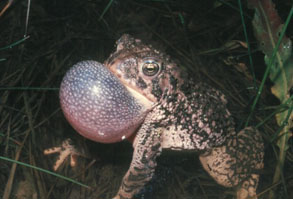Toads generally do not drink in the usual sense but instead absorb water from soil through their “seat patch,” a highly vascular area of thin skin under the rump.
Photo Credit: Geoffrey A. Hammerson
Anaxyrus woodhousii
Common Name: Woodhouse's toad
Other Scientific Names: Bufo woodhousii
Animal Guild: Amphibian
Class > Order > Family: Amphibia > Anura > Bufonidae
What does the species look like?
Adults: Adults have a yellowish-brown, grayish, or olive back, with small, dark spots that usually contain one to two warts. They usually have a light stripe down the middle of their back and a raised ridge between their eyes. They typically reach a length of up to 5 inches (12.7 cm). Females grow much larger than males.
Mature males: During the breeding season, males have a dark throat and dark patches on the inner surfaces of their first and second toes on their front feet.
Breeding call: A loud “waaaaaah” lasting about one to four seconds and emitted up to several times per minute.
Juveniles: Juveniles lack the stripe that adults have down the middle of their back. Some of their warts are usually reddish, and they can be misidentified as red-spotted toads.
Larvae: Tadpoles have brown or dark gray backs, often with light mottling or dense, gold flecking. Their head is narrow when viewed from above. The snout end is more pointed and the overall body shape is more triangular than those of the red-spotted toad. Their belly is gold with black mottling. Their fins are mainly clear with some pigment flecks, more in the upper fin than in the lower. Their tail musculature is dark with light mottling or gold flecking, and is pale along the lower edge. They generally reach a total length of at least 1.4 inches (35 mm) in Colorado, and probably a similar size in other locations too.
Eggs: Eggs are black above, tan below, and 0.0 to 0.1 inches (1.0 to 1.5 mm) in diameter. Adults lay eggs in long strings in a single jelly envelope. There can be one or two rows of eggs in each jelly string.
Where is the species found?
States & Provinces
AZ, CA, CO, IA, ID, KS, LA, MO, MT, ND, NE, NM, NV, OK, OR, SD, TX, UT, WA, WY
Distribution
This species is found throughout most of the central and southwestern United States and portions of adjacent northern Mexico. It is absent from high mountains and the West Coast.
This species prefers grasslands, desert and semi-desert shrublands, river valleys and floodplains, and agricultural areas. Woodhouse's toads live on land except during the brief breeding season.
General Phenology and Life History
After rains in the spring or summer, these toads migrate from their land-based habitat to water where they breed. They breed in marshes, rain pools, ponds, lakes, reservoirs, flooded areas, stream pools, and other bodies of water with shallow water along the edge, without fish, and without a strong current. Larvae metamorphose into tiny toadlets within 1 to 2 months after hatching.
Special Considerations for Observing
Which phenophases should I observe?
Do you see/hear...?
Activity
Adults on land More...
For abundance, enter the number of individual animals observed in this phenophase.
Adults in water More...
For abundance, enter the number of individual animals observed in this phenophase.
Adults feeding For abundance, enter the number of individual animals observed in this phenophase.
Reproduction
Vocalizing What is the intensity of vocalizing?
Single calls: There is space between calls and individuals can be counted. Overlapping calls: Calls of individuals can be distinguished but there is some overlapping of calls. Full chorus: Calls are constant and overlapping.
Mating For abundance, enter the number of individual animals observed in this phenophase.
Fresh eggs For abundance, enter the number of individual animals observed in this phenophase.
Development
Dead adults For abundance, enter the number of individual animals observed in this phenophase.
What do these phenophases look like?
There is currently no photoguide available for this species. If you'd like help us create one, use the guidance document and species template provided here . Then send it via email to education@usanpn.org when it is complete.
